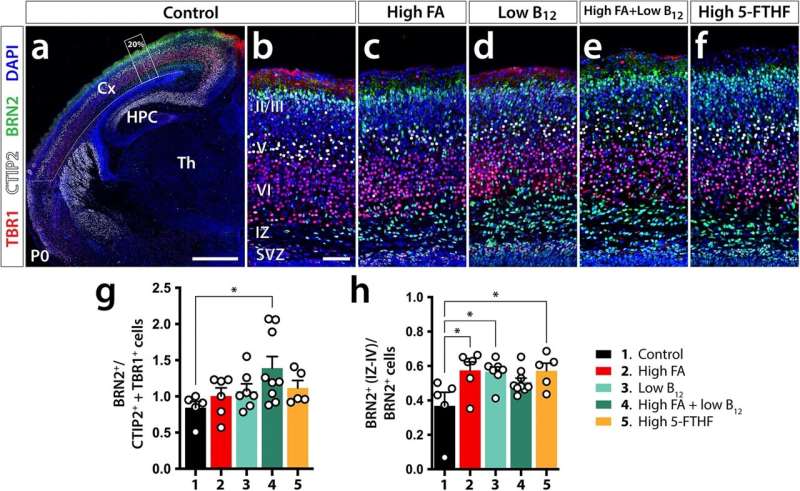This article has been reviewed according to Science X's editorial process and policies. Editors have highlighted the following attributes while ensuring the content's credibility:
fact-checked
peer-reviewed publication
trusted source
proofread
High folic acid and low B12 can affect fetal brain development in mice

Folate is a B vitamin and a necessary nutrient to prevent neural tube defects, such as spina bifida. Folic acid, a synthetic form of folate, has been added to vitamins, breakfast cereals, and other products in the U.S. and more than 80 other countries to ensure pregnant women get adequate amounts. However, new research suggests there may be such a thing as too much folic acid.
In a study published in Communications Biology, researchers from the UC Davis School of Medicine and the UC Davis MIND Institute showed that imbalances in folic acid and vitamin B12 can alter brain development in mice.
"There's no doubt the introduction of folic acid diet fortification has been beneficial, substantially lowering the incidence of neural tube defects," said Ralph Green, distinguished professor in the Department of Pathology and Laboratory Medicine and co-senior author of the study. "However, too much folic acid may have detrimental impacts on brain development, and that's something we need to sort out."
Concerns about folate deficiencies and neural tube defects, which can lead to stillbirths, paralysis, cognitive disabilities, and other issues, peaked in the 1990s. At the time, the Food and Drug Administration and Centers for Disease Control and Prevention revised guidelines to ensure people who were pregnant got the necessary amounts. Green played an important role in developing these standards.
However, the timing of folate during pregnancy is tricky. The neural tube forms early in pregnancy and usually closes about 28 days after conception. This meant targeted folate supplements would likely arrive too late.
The solution was to fortify foods and vitamins with folic acid, the synthetic form of folate, to ensure pregnant people received enough. In the decades since folic acid fortification began, neural tube defects have declined dramatically.
During that same time, the prevalence of neurodevelopmental conditions such as autism and attention-deficit/hyperactivity disorder (ADHD) increased. Epilepsy rates rose as well. The researchers wanted to explore whether there is a possible link between these increases and excessive folic acid.
Green notes that folic acid fortification may be an imperfect solution.
"The food industry has been adding folic acid to breakfast cereals, snack foods, and vitamins, and that has likely increased intake above recommended guidelines," Green said. "The safe upper limit for folate is 1,000 micrograms per day. The National Health and Nutrition Examination Survey data showed that a substantial percentage of women's diets were above that limit."
The consequences of high folic acid and low B12
Green and colleagues have been studying this issue for several years. In a 2020 paper published in Cerebral Cortex, the group showed that both folate overabundance and deficiency could cause neurodevelopmental issues in mice.
In the new study, the team investigated the effects of high folic acid intake, B12 deficiency, and high amounts of a natural folate—folinic acid—that may act differently than folic acid. The body needs B12 to recycle and adequately use folate.
The investigators supplied a group of mice before and during pregnancy with a controlled diet containing normal levels of folic acid and B12 and four separate groups with diets that either included:
- high folic acid
- low B12
- high folic acid with low B12
- high folinic acid
Using multiple imaging techniques, the offspring of these pregnancies were examined with a focus on the development of the cerebral cortex, the primary brain structure associated with important cognitive and emotional functions. The cerebral cortex is central to a range of psychiatric disorders, particularly those that first appear in childhood.
"These different dietary conditions appear to influence the way neurons arise in the developing brain," said Konstantinos Zarbalis, professor of pathology and laboratory medicine, faculty member of the UC Davis MIND Institute, and co-senior author.
"With high levels of folic acid or B12 deficiency, there was a change in neural development. Cortical neurons that usually emerge during a later stage of brain development were produced over a longer period of time and required a longer period to settle in and assume their proper position in the developing brain. In addition, both high folic acid and B12 deficiency appear to cause many neurons to develop fewer interconnections," Zarbalis said.
The exception was folinic acid, the natural folate. Even though it was given at the same high levels as folic acid, there were virtually no consequences to developing mouse brains.
As researchers expected, the group given a diet that combined high folic acid with low B12 showed the most pronounced neurodevelopmental abnormalities.
While these results are intriguing and may eventually be linked to human pathology, the authors stress the need for abundant caution. Animal models differ from humans in key ways, including metabolic rates and the efficiency with which they process folic acid.
In ongoing work, the team is investigating the effects of folic acid and B12 in human brain organoids (3D cell clusters that incorporate several neural cell types). This research may provide better insights into how these nutrients affect human biology.
"There's a lot of complexity in how the body responds to folic acid, vitamin B12, and folinic acid. We are at the early stages of determining how these elements interact," Zarbalis said. "Ultimately, we would like to find a definitive answer for how much folate, and what form, is optimal to avoid neural tube defects and other potential brain health issues."
More information: Lyvin Tat et al, Prenatal folic acid and vitamin B12 imbalance alter neuronal morphology and synaptic density in the mouse neocortex, Communications Biology (2023). DOI: 10.1038/s42003-023-05492-9




















